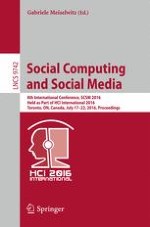This book constitutes the refereed proceedings of the 8th International Conference on Social Computing and Social Media, SCSM 2016, held as part of the 18th International Conference on Human-Computer Interaction, HCII 2016, held in Toronto, ON, Canada, in July 2016. The total of 1287 papers and 186 posters presented at the HCII 2016 conferences were carefully reviewed and selected from 4354 submissions.
The papers thoroughly cover the entire field of Human-Computer Interaction, addressing major advances in knowledge and effective use of computers in a variety of application areas. The 43 contributions included in the SCSM 2016 proceedings were organized in the following topical sections: designing and developing social media; users behaviour in social media; social media, policy, politics and engagement; social network analysis; social media in learning and collaboration; and enterprise social media.
